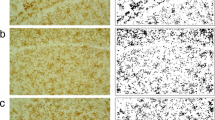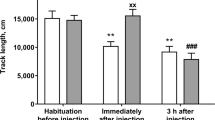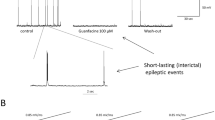Abstract
Repeated electroconvulsive shock is an effective treatment for affective disorders. Striatum, hippocampus and brainstem are involved in affective disorders. Sodium–potassium/ATPase is of paramount importance for the proper functioning of the brain and its involvement in the affective disorders has been claimed for a long time. Sodium–potassium/ATPase has an extracellular regulatory binding site to which cardiotonic glycosides, such as ouabain, bind to, thus regulating the activity of the enzyme. Endogenous “ouabain-like” substances exist in the brain and their actions on the sodium–potassium/ATPase resemble ouabain biological properties. The aim of this work was to determine if electroconvulsive shock (ECS) would induce changes in the high-affinity binding of ouabain to the sodium–potassium/ATPase from rat brain regions. Adult, male Wistar rats received one (ECS×1 group) or seven electroshocks (ECS×7 group) delivered daily through ear-clips electrodes. Control rats received the same manipulations; however, no current was delivered through the electrodes (SHAM×1 and SHAM×7 groups). All groups were sacrificed 24 h after the last ECS session. The B max and K D of high-affinity [3H]-ouabain binding were determined in crude membrane preparations from the striatum, hippocampus and brainstem. The results obtained showed a statistically significant increase in the affinity of [3H]-ouabain (lower K D) to striatal membranes in those rats receiving seven ECS. In the striatum there was no change in the K D after one ECS; as well as there was no change in the B max after a single or seven ECS. High-affinity [3H]-ouabain binding to hippocampus and brainstem did not reveal any significant differences either in K D or B max after one or seven ECS. The increased affinity of ouabain to the striatal sodium–potassium/ATPase induced by repeated ECS suggests an increased interaction in vivo of the endogenous “ouabain-like” substances with the enzyme and the involvement of the extracellular regulatory allosteric ouabain binding site in the striatal sodium–potassium/ATPase in the effects of electroconvulsive shock.







Similar content being viewed by others
References
Sackeim HA, Devanand DP, Nobler MS (1995) Electroconvulsive therapy. In: Bloom FE, Kupfer DJ (eds) Psychopharmacology: The fourth generation of progress. Raven Press, New York, pp 1123–1141
Fossati P, Radtchenlo A, Boyer P (2004) Neuroplasticity: from MRI to depressive symptoms. Eur Neuropsychopharmacol 14:S503–S510
Rogers MA, Bradshaw JL, Pantelis C, Phillips JG (1998) Frontostriatal deficits in unipolar depression. Brain Res Bull 47:297–310
Strakowski SM, DelBelo MP, Adler C, Cecil KM, Sax KW (2000) Neuroimaging in bipolar disorder. Bipolar Disord 2:148–164
Blanco G, Mercer RW (1998) Isozymes of the Na-K-ATPase: heterogeneity in structure, diversity in function. Am J Physiol 275:F633–F650
Horisberger JD, Lemas V, Kraehenbühl JP, Rossier BC (1991) Structure-function relationship of Na,K-ATPase. Annu Rev Physiol 53:565–584
Béguin P, Wang X, Firsov D, Puoti A, Claeys D, Horisberger JD, Geering K (1997) The γ subunit is a specific component of the Na,K-ATPase and modulates its transport function. EMBO J 16:4250–4260
Jamme I, Barbey O, Trouvé P, Charlemagne D, Maixent JM, Mackenzie ET, Pellerin L, Nouvelot A (1999) Focal cerebral ischaemia induces a decrease in activity and a shift in ouabain affinity of Na+, K+-ATPase isoforms without modifications in mRNA and protein expression. Brain Res 819:132–142
Rodríguez de Lores Arnaiz G, Reinés A, Herbin T, Peña C (1998) Na+, K+-ATPase interaction with a brain endogenous inhibitor (endobain E). Neurochem Int 33:425–433
Gao J, Wymore RS, Wang Y, Gaudette GR, Krukenkamp IB, Cohen I, Mathias RT (2002) Isoform-specific stimulation of cardiac Na/K pumps by nanomolar concentrations of glycosides. J Gen Physiol 119:297–312
Rodríguez de Lores Arnaiz G (2000) How many endobains are there? Neurochem Res 25:1421–1430
Lichtstein D, Rosen H (2001) Endogenous digitalis-like Na+, K+-ATPase inhibitors, and brain function. Neurochem Res 26:971–978
Bagrov AY, Bagrov YY, Fedorova OV, Kashkin VA, Patkina NA, Zvartau EE (2002) Endogenous digitalis-like ligands of the sodium pump: possible involvement in mood control and ethanol addiction. Eur Neuropsychopharmacol 12:1–12
Westerink BH, Damsma G, de Vries JB (1989) Effect of ouabain applied by intrastriatal microdialysis on the in vivo release of dopamine, acetylcholine, and amino acids in the brain of conscious rats. J Neurochem 42:705–712
Bersier MG, Miksztowicz V, Peña C, Rodríguez de Lores Arnaiz G (2005) Modulation of aspatate release by ascorbic acid and endobain E, an endogenous Na+, K+-ATPase inhibitor. Neurochem Res 30:479–486
Vatta M, Peña C, Fernández BE, Rodríguez de Lores Arnaiz G (2004) Endobain E, a brain Na+, K+-ATPase inhibitor, decreases norepinephrine uptake in rat hypothalamus. Life Sci 76:359–365
Vatta M, Peña C, Fernández B, Rodríguez de Lores Arnaiz G (1999) A brain Na+, K+-ATPase inhibitor (endobain E) enhances norepinephrine release in rat hypothalamus. Neuroscience 90:573–579
Sirinathsinghji DJ, Heavbens RP, Sikdar SK (1988) In vivo studies on the dopamine re-uptake mechanism in the striatum of the rat: effects of benztropine, sodium and ouabain. Brain Res 438:399–403
Rodríguez de Lores Arnaiz G, Schneider P, Peña C (1999) Brain soluble fractions which modulate Na+, K+-ATPase activity likewise modify muscarinic receptor. Neurochem Res 24:1417–1422
Meyer EM, Cooper JR (1981) Correlations between Na+-K+ ATPase activity and acetylcholine release in rat cortical synaptosomes. J Neurochem 36:467:475
Xie Z, Cai T (2003) Na+-K+-ATPase-mediated signal transduction: from protein interaction to cellular function. Mol Interv 3:157–168
Lopina OD (2001) Interaction of Na,K-ATPase catalytic subunit with cellular proteins and other endogenous regulators. Biochemistry (Mosc) 66:1122–1131
Looney SW, El-Mallakh RS (1997) Meta-analysis of erythrocyte Na,K-ATPase activity in bipolar illness. Depress Anxiety 5:53–65
Christo PJ, El-Mallakh RS (1993) Possible role of endogenous ouabain-like compounds in the pathophysiology of bipolar illness. Med Hypotheses 41:378–383
Hauger R, Luu HMD, Meyer DK, Goodwin FK, Paul SM (1985) Characterization of “high-affinity” [3H]ouabain binding in the rat central nervous system. J Neurochem 44:1709–1715
Lowry OH, Rosebrough NJ, Farr AL, Randall RJ (1951) Protein measurement with the Folin phenol reagent. J Biol Chem 193:265–275
Lerer B (1987) Neurochemical and other biological consequences of ECT: implications for the pathogenesis and treatment of affective disorders. In: Meltzer HY (ed) Psychopharmacology: The third generation of progress. Raven Press, New York, pp. 577–588
Jay TM (2003) Dopamine: a potential substrate for synaptic plasticity and memory mechanisms. Progr Neurobiol 69:375–390
Calabresi P, De Murtas M, Bernardi G (1997) The neostriatum beyond the motor function: experimental and clinical evidence. Neuroscience 78:39–60
De Murtas M, Tatarelli R, Girardi P, Vicini S (2004) Repeated electroconvulsive stimulation impairs long-term depression in the neostriatum. Biol Psychiatry 55:472–476
Yoshida K, Higushi H, Kamata M, Yoshimoto M, Shimiau T, Hishikawa Y (1997) Dopamine releasing response in rat striatum to single and repeated electroconvulsive shock treatment. Prog Neuro-Psychopharmacol Biol Psychiat 21:707–715
Reid IC, Stewart CA (1997) Seizures, memory and synaptic plasticity. Seizure 6:351–359
Pekovic S, Nedeljkovic N, Nikezic G, Horvat A, Stojiljkovic M, Rakic L, Martinovic JV (1997) Biochemical characterization of the hippocampal and striatal Na,K-ATPase reveals striking differences in kinetics properties. Gen Physiol Biophys 16:227–240
Bertorello AM, Hopfield JF, Aperia A, Greengard P (1990) Inhibition by dopamine of (Na++K+)ATPase activity in neostriatal neurons through D1 and D2 dopamine receptor synergism. Nature 347:386–388
Nishi A, Fisone G, Snyder GL, Dulubova I, Aperia A, Nairn AC, Greengard P (1999) Regulation of Na+,K+-ATPase isoforms in rat neostriatum by dopamine and protein kinase C. J Neurochem 73:1492–1501
Akagawa K, Tsukada Y (1979) Presence and characteristics of catecholamine-sensitive Na-K ATPase in rat striatum. J Neurochem 32:269–271
Kamata K, Kamata M, Ino H, Kameyama T (1980) Change in catecholamine-sensitive Na+,K+-ATPase activity in the rat striatum microsomes following electrolytic or 6-hydroxydopamine-induced lesions of dopaminergic neurons. Jpn J Pharmacol 30:401–404
van der Krogt JA, Belfroid RDM (1980) Characterization and localization of catecholamine-susceptible Na-K ATPase activity of rat striatum: studies using catecholamine receptor (ant)agonists and lesion techniques. Biochem Pharmacol 29:857–858
Passarelli F, Carmenini E, Calo L, Pontieri FE (1997) Dopamine release in striatal slices of rats previously submitted to electroconvulsive shock. Brain Res 774:239–241
Barkai AI, Durkin M, Nelson HD (1990) Localized alterations of dopamine receptor binding in rat brain by repeated electroconvulsive shock: an autoradiographic study. Brain Res 529:208–213
Smith S, Lindefors N, Hurd Y, Sharp T (1995) Electroconvulsive shock increases dopamine D1 and D2 receptor mRNA in the nucleus accumben of the rat. Psychopharmacology 120:333–340
Newman ME, Lerer B (1989) Effects of chronic electroconvulsive shock on D1 and D2 dopamine receptor-mediated activity of adenylate cyclase in homogenates of striatum and limbic forebrain of rat. Neuropharmacology 28:787–790
Li S, Wattenberg EV (1998) Differential activation of mitogen-activated protein kinase by palytoxin and ouabain, two ligands for the Na+,K+-ATPase. Toxicol Appl Pharmacol 151:377–384
Oh SW, Ahn YM, Kang UG, Kim YS, Park JB (1999) Differential activation of c-Jun N-terminal protein kinase and p38 in rat hippocampus and cerebellum after electroconvulsive shock. Neurosci Lett 271:101–104
Brecht S, Simler S, Vergnes M, Mielke K, Marescaux C, Herdegen T (1999) Repetitive electroconvulsive seizures induce activity of c-Jun N-terminal kinase and compartment-specific desensitization of c-Jun phosphorylation in the rat brain. Brain Res Mol Brain Res 68:101–108
Mishra OP, Delivoria-Papadopoulos M, Cahillane G, Wagerle LC (1989) Lipid peroxidation as the mechanism of modification of the affinity of the Na+,K+-ATPase active sites for ATP, K+, Na+, and strophanthidin in vitro. Neurochem Res 14:845–851
Barichello T, Bonato F, Agostinho FR, Reinke A, Moreira JCF, Dal-Pizzol F, Izquierdo I, Quevedo J (2004) Structure-related oxidative damage in rat brain after acute and chronic electroshock. Neurochem Res 29:1749–1753
Acknowledgements
We thank Marcela I.F. Venditti for her help in the preparation of this manuscript. Magda Bignotto was a recipient of a fellowship from Coordenação de Pessoal de Nível Superior (CAPES). This work was funded by Associação Fundo de Incentivo à Psicofarmacologia (AFIP).
Author information
Authors and Affiliations
Corresponding author
Rights and permissions
About this article
Cite this article
Bignotto, M., Benedito, M.A.C. Repeated Electroconvulsive Shock Induces Changes in High-affinity [3H]-ouabain Binding to Rat Striatal Membranes. Neurochem Res 31, 515–521 (2006). https://doi.org/10.1007/s11064-006-9046-6
Accepted:
Published:
Issue Date:
DOI: https://doi.org/10.1007/s11064-006-9046-6




